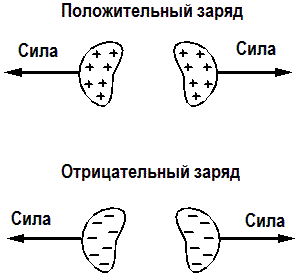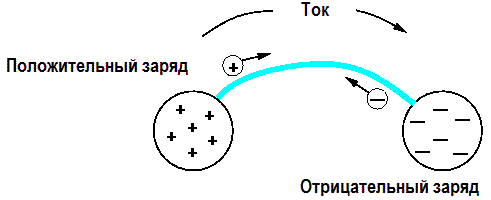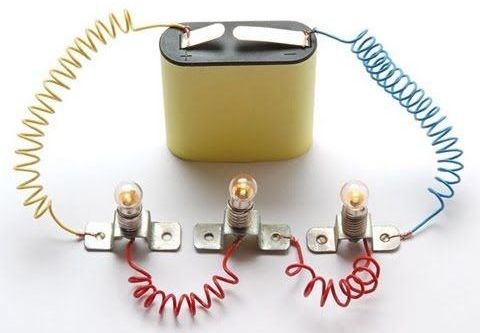Direction of electric current
We connect the LED to the finger battery, and if the polarity is observed correctly, it will light up. In what direction will the current be established? Nowadays everyone knows this from plus to minus. And therefore inside the battery from minus to plus — after all, the current in this closed electrical circuit is constant.
The direction of movement of positively charged particles is considered the direction of current in the circuit, but after all, electrons move in metals, and they, we know, are negatively charged. This means that, in fact, the term "current direction" is a convention. Let's figure it out why, as electrons pass through the circuit from minus to plus, everyone around them says that the current goes from plus to minus... Why is this absurd?

The answer lies in the history of electrical engineering formation. When Franklin developed his theory of electricity, he considered its motion to be that of a fluid, which seemed to flow from one body to another. Where there is more electric fluid, it flows in the direction where there is less of it.
For this reason, Franklin called bodies with an excess of electric fluid (conditionally!) Positively electrified, and bodies with a lack of electric fluid, negatively electrified. That's where the idea of movement comes from. electrical charges… The positive charge flows, as if through a system of communicating vessels, from one charged body to another.
Later, the French researcher Charles Dufay in his experiments with electrifying friction found that not only rubbed bodies but also rubbed bodies are charged, and upon contact the charges of both bodies are neutralized. It turns out that there are actually two separate types of electric charge that, when they interact, cancel each other out. This two-electricity theory was developed by Franklin's contemporary, Robert Simmer, who had himself become convinced that something in Franklin's theory was not entirely correct.

Scottish physicist Robert Simmer wore two pairs of socks: warm woolen socks and a second silk one on top. When he removed both socks from his foot at once and then removed one sock from the other, he noticed the following picture: the woolen and silk socks swelled up, as if taking the shape of his feet and sticking sharply to each other. At the same time, socks made of the same material, such as wool and silk, repel each other.
If Simmer held two silk socks in one hand and two woolen socks in the other, then when he brought his hands together, the repulsion of socks of the same material and the attraction of socks of different materials led to an interesting interaction between them: different socks as if they pounced on each other and entwined into a ball.
Observations on the behavior of his own socks led Robert Simmer to the conclusion that in every body there are not one, but two electrical fluids, positive and negative, which are contained in the body in equal amounts.
When two bodies rub, one of them can pass from one body to another, then there will be an excess of one of the liquids in one body, and its deficiency in the other. Both bodies will become electrified, opposite in sign electricity.
Nevertheless, electrostatic phenomena can be successfully explained using both Franklin's hypothesis and Simmer's hypothesis of two electric forces. These theories have been competing with each other for some time.
When in 1779 Alessandro Volta created his voltaic column, after which electrolysis was studied, scientists came to the unequivocal conclusion that indeed two opposite streams of charge carriers move in solutions and liquids - positive and negative. The dualistic theory of electric current, although not understood by all, nevertheless triumphed.
Finally, in 1820, speaking before the Paris Academy of Sciences, Ampere proposed to choose one of the directions of charge movement as the main direction of current. It was convenient for him to do this because Ampere was studying the interaction of currents with each other and currents with magnets. And so every time during a message let alone two streams of opposite charge move in two directions along one wire.
Ampere proposed simply to take the direction of movement of positive electricity for the direction of the current and all the time to speak of the direction of the current, which means the movement of a positive charge... Since then the position of the direction of the current proposed by Ampere has been accepted everywhere and is used and until today.

When Maxwell developed his theory of electromagnetism and decided to apply the right-hand screw rule for convenience in determining the direction of the magnetic induction vector, he also adhered to this position: the direction of current is the direction of movement of a positive charge.
Faraday, for his part, notes that the direction of the current is conditional, it is just a convenient tool for scientists to unambiguously determine the direction of the current. Lenz introducing his Lenz rule (see — Basic laws of electrical engineering), also uses the term «current direction» to mean the movement of positive electricity. It's just convenient.
And even after Thomson discovered the electron in 1897, the convention of current direction still held. Even if only electrons actually move in a wire or in a vacuum, the reverse direction is still taken as the direction of current — from plus to minus.
 More than a century after the discovery of the electron, despite Faraday's ideas about ions, even with the appearance of electron tubes and transistors, although there were difficulties in the descriptions, the usual state of affairs still remains. So it is more convenient to work with currents, to navigate their magnetic fields, and it seems that this does not cause real difficulties for anyone.
More than a century after the discovery of the electron, despite Faraday's ideas about ions, even with the appearance of electron tubes and transistors, although there were difficulties in the descriptions, the usual state of affairs still remains. So it is more convenient to work with currents, to navigate their magnetic fields, and it seems that this does not cause real difficulties for anyone.
See also:Conditions for the existence of electric current
